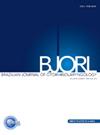基于超高分辨率CT的假体位置对耳硬化患者听力结果的影响
IF 1.8
4区 医学
Q2 OTORHINOLARYNGOLOGY
引用次数: 0
摘要
目的基于超高分辨率CT (uhrct),探讨假体体位对耳硬化症患者听力结果的影响。方法回顾性分析142例(182耳)镫骨切开术患者的临床资料。我们比较了术前和术后的听力结果。经验丰富的放射科医师从U-HRCT图像中提取镫骨假体的数据,包括绝对插入深度、相对插入深度、假体与砧骨之间的角度、假体与脚板之间的角度以及钩夹在砧骨长程上的相对位置。我们分析了成像数据与术后听力结果之间的潜在关系。结果129耳术后获得满意的听力效果。119耳(92.2%)在0 ~ 20 dB范围内出现气骨间隙(ABG)。我们观察到术前和术后不同频率(0.5、1、2和4 kHz)的平均ABG差异有统计学意义。在2 kHz时效果最好(98.5%)。我们发现假体插入深度(平均0.6 mm,相对深度:平均23%)和假体与砧木之间的平均角度(平均91.2°)的观察值是安全有效的。我们还发现假体与足板之间的平均角度与术后ABG有关(p = 0.049)。钩在牙长程上的位置(相对距离10.5%)也是决定术后听力结果的关键因素(p = 0.726)。结论假体位置与术后听力预后相关。术后影像学评估对于没有从镫骨手术中获益的患者尤为重要。证据等级:3级。本文章由计算机程序翻译,如有差异,请以英文原文为准。
Impact of prosthesis position on hearing outcomes in otosclerosis patients based on ultra-high-resolution CT
Objectives
This study aimed to explore the impact of prosthesis position on hearing outcomes in otosclerosis patients based on Ultra-High-Resolution CT (U-HRCT).
Methods
We retrospectively reviewed medical records of 142 patients (182 ears) who underwent stapedotomy. We compared preoperative with postoperative hearing results. An experienced radiologist extracted data about stapes prostheses from U-HRCT images, including absolute insertion depth, relative insertion depth, angle between the prosthesis and incus, angle between the prosthesis and footplate, and the relative position of the hook clamped onto the long process of incus. We analyzed potential relationships between the imaging data and postoperative hearing outcomes.
Results
We obtained satisfactory hearing results from 129 ears postoperatively. 119 ears (92.2%) presented Air-Bone Gaps (ABG) in the 0–20 dB range. We observed statistically significant differences between mean pre- and post-operative ABG at different frequencies (0.5, 1, 2, and 4 kHz). The best results occurred at 2 kHz (98.5%). We found that the observed values for prosthesis insertion depth (mean 0.6 mm, relative depth: mean 23%) and mean angle between the prosthesis and incus (mean 91.2 °) were safe and effective. We also found that the mean angle between prosthesis and footplate was related to postoperative ABG (p = 0.049). The hook position on the long process of incus (relative distance of 10.5%) is also a crucial factor in determining postoperative hearing results (p = 0.726).
Conclusion
Prosthesis position and postoperative hearing outcomes are related. Postoperative imaging evaluation is especially important for patients who did not benefit substantially from stapes surgery.
Level of evidence
Level 3.
求助全文
通过发布文献求助,成功后即可免费获取论文全文。
去求助
来源期刊

Brazilian Journal of Otorhinolaryngology
OTORHINOLARYNGOLOGY-
CiteScore
3.00
自引率
0.00%
发文量
205
审稿时长
4-8 weeks
期刊介绍:
Brazilian Journal of Otorhinolaryngology publishes original contributions in otolaryngology and the associated areas (cranio-maxillo-facial surgery and phoniatrics). The aim of this journal is the national and international divulgation of the scientific production interesting to the otolaryngology, as well as the discussion, in editorials, of subjects of scientific, academic and professional relevance.
The Brazilian Journal of Otorhinolaryngology is born from the Revista Brasileira de Otorrinolaringologia, of which it is the English version, created and indexed by MEDLINE in 2005. It is the official scientific publication of the Brazilian Association of Otolaryngology and Cervicofacial Surgery. Its abbreviated title is Braz J Otorhinolaryngol., which should be used in bibliographies, footnotes and bibliographical references and strips.
 求助内容:
求助内容: 应助结果提醒方式:
应助结果提醒方式:


